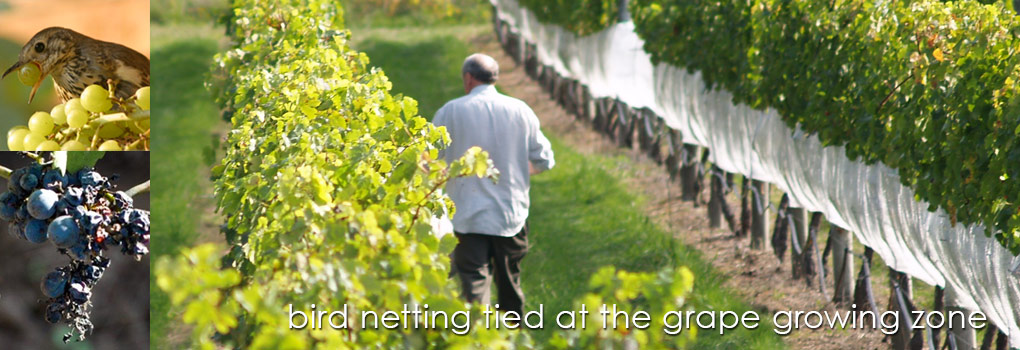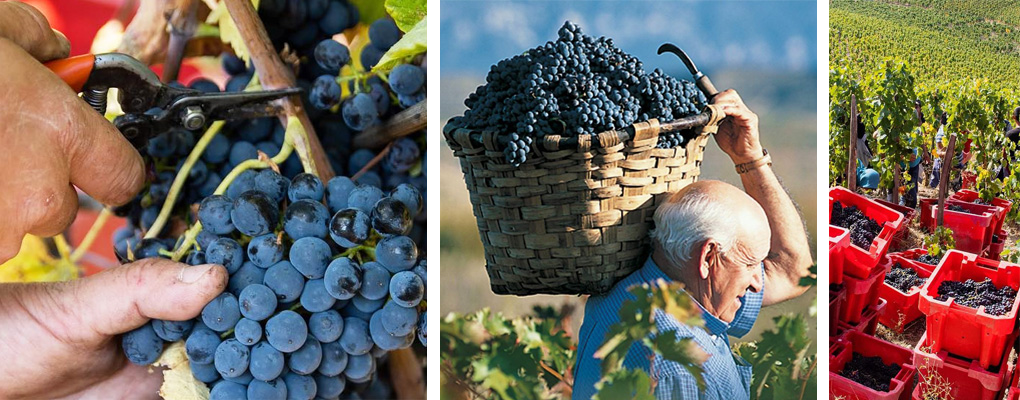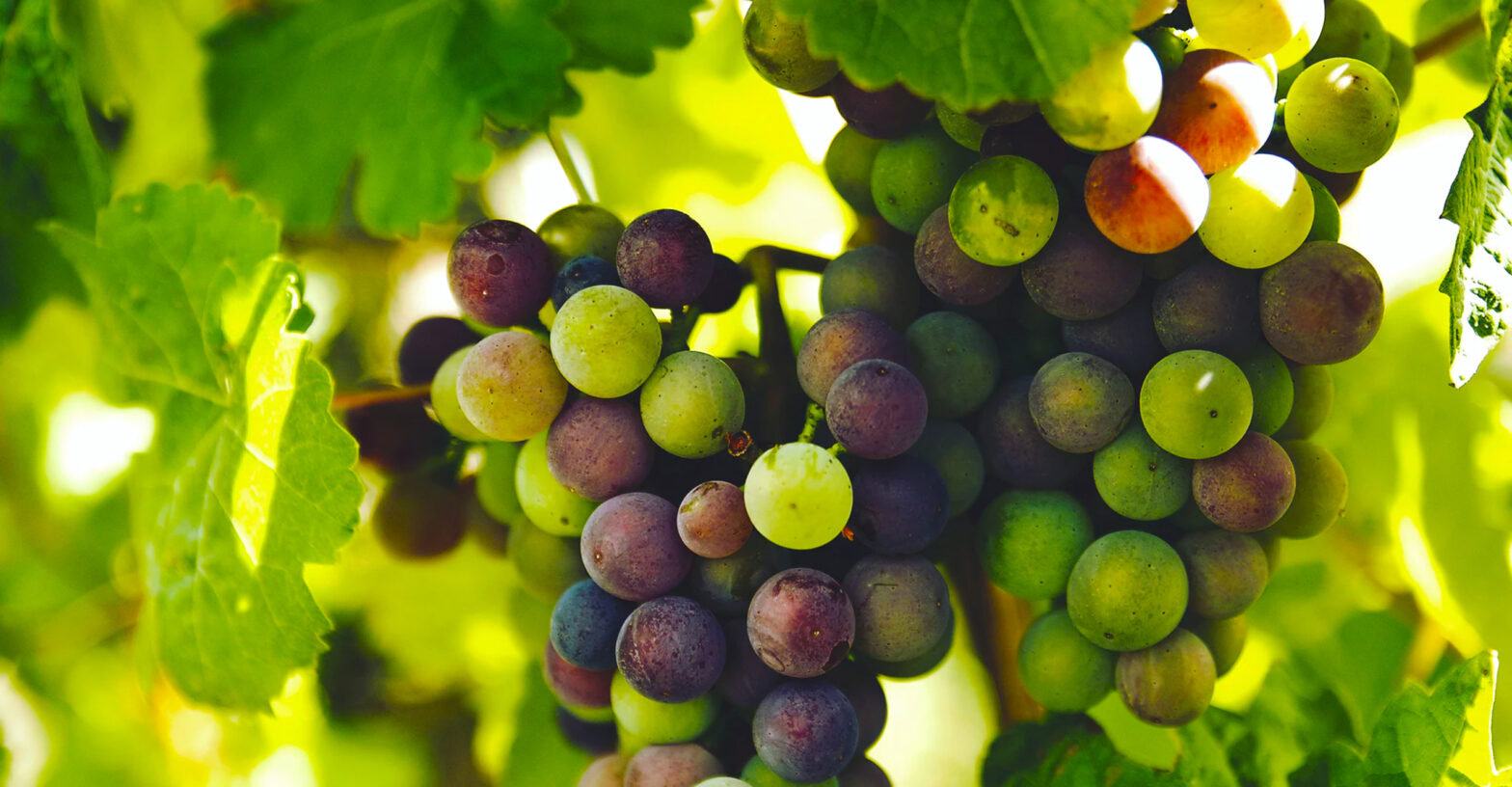Picking too early or too late ?
The decision of when to pick a certain parcel of wine grapes carries much weight. Picking too early or picking too late both bring consequences to the resulting wine. Each decision can be detrimental to the finished wine in regard to its aroma, range of flavour, structure and overall enjoyment. It is not an easy skill to be able taste a grape in the vineyard straight off the vines and tell at what stage of physiological ripeness and where its ripening cycles will go from here, as a number of variables need be taken into account.
A wine grape is not physiological ripe for example if it is simply sweet and not acidic. In fact, some acidity is beneficial to a well-balanced wine. The goal is to find the right balance between sweetness and the varietals natural acidity.
Grape sampling takes place frequently - in the last few weeks of the season, to determine the current sugars, pH, and acidity of the grapes, as close monitoring of these changes is necessary in the days before harvest. Then for example a few too many days growing on the vine and too much sun exposure can make the numbers change all too quickly.
Also while sugars are accumulating inside grapes during the growing season, tannins and phenolic compounds are also ripening. This type of ripeness relates to the grape skins, seeds and even the stalks. The ultimate and ideal timing of readiness for when to pick is when all of these variables happen simultaneously. For this to occur, vines need just the right amount of sunlight, water, available soil nutrients and appropriate vineyard and canopy management.
Winemakers need to make a careful decision when to pick if they want their wines to be balanced. If they pick too soon, the acid levels will be too high, the sugars too low and the tannins too aggressive. If they pick too late, the sugar levels will be too high, the acids too low and the tannins will have evolved to a point where they will not provide the wine the required structure. In theory this all sounds simple, but the devil is in the detail.
The numerous chemical changes occurring during the ripening process take place in a complicated sequence, and are highly responsive to local conditions. In wine regions, where summers had just enough heat to ripen the varietals planted, the higher the sugar levels the better, because once the grapes have reached about 12 degrees potential alcohol, they would generally be ripe in all the other ways, (give or take small variations). Though because of the constant threat of early autumn rains, it would not pay to leave wine grapes on the vine much beyond this point: as there was a risk of severe quality loss if it started rain heavily while the grapes remain unpicked.
As vines began to be planted in new, warmer wine regions, where an average summer has more than enough capacity to ripen the varietals, the rules slightly changed. Picking by sugar levels resulted in harvesting grapes that made wine with distinctive green characteristics and unresolved tannins: the grapes were not fully ripe. This new concept became dubbed ‘physiological’ or ‘phenolic’ ripeness. In these warmer climates the process of sugar ripeness (with rising sugars and lowering acids) seemed to have become uncoupled from the process of physiological ripeness. So growers began leaving the grapes on the vines longer, leading to a concept dubbed as ‘hang time’. Today, several ‘new world’ winemakers often allow their fruit to hang a little longer to taste of riper fruit, meaning grape sugars will be much higher and with less natural acidity left in the grapes - which can result in an earlier drinking wine, but one that can not age as long.
This extra hang time was not such a risk in warmer climates, as rain is not a serious threat. This opened up possibilities to winemakers: picking became much more of a stylistic choice than a necessity. Winemakers found that the longer they left the grapes on the vine, the more some consumers and critics enjoyed the resulting wines. They became richer, with a sweeter fruit profile and softer tannins. They also became more concentrated with more texture and darker colour. The alcohol levels became higher, mainly because of increased sugar levels but also because the grapes started dehydrating on the vine as they were left to hang.
With vineyard improvements - we now have vertical canopies with good bud spacing, improved clones and rootstocks, good soil nutrition and water management - all leading to the highly desirable result of more rapid and complete ripening with more flavour and colour along with better acidity. For most vineyards and varietals, there is an ideal picking window (which does slide by a few days each growing season) when the grapes fall within acceptable parameters for ripeness. Where one chooses to pick is then a stylistic decision.
Pick too late, and the tannins will have already undergone lots of modification on the vine. The wine may taste soft and sweet, but there will be very little opportunity for the tannins to develop. It could well be that as well as making more complicated viticultural interventions to bring sugar levels down, a little compromise with early drinkability could result in wines that have more potential for ageing, and which are more interesting expressions.

Veraison:
Veraison (va-ray-zon) is a French term that has been adopted into English wine-phrases regarding viticulture and grape growing. One simple definition of veraison is: 'the change in colour of the grape berries'. Veraison marks the transition period from berry growth to berry ripening, and several changes in berry maturation occur during veraison.
The exact trigger of veraison is unknown, but veraison signifies that the grape seed is reaching maturity. However, seed maturity is unlikely the cause, as seedless grapes also go through veraison. In the northern hemisphere veraison, the ripening grapes begin to soften and change colour typically occurs anytime from late June to mid-August, depending on the climate, and in the southern hemisphere from January to February.
During veraison tannins ripen and astringent malic acid begins to give way to softer tartaric acid. Leaves are often pruned, thinned at this time to give grapes more sunlight and air exposure. Mildew and disease are still a worry for viticulturists and spraying may continue in some vineyards. Sugar levels begin to rise in individual grapes after veraison. At this stage of the growing cycle, vines are rarely irrigated after veraison because this can and will dilute the grapes flavours.
A little winemaking 101 - as the seeds ripen so does the rest of the grape. In this process called veraison, the thick, hard green skins soften and change to either red-black (due to anthocyanins) or yellow-green (due to carotenoids) depending on the grape varietal. At this time of the growing season, sugars and berry volume increase dramatically and acidity decreases as the grapes reach the home stretch before harvest.
Overall, the grape approximately doubles in size (primarily water) between the beginning of the second growth period, veraison and then harvest. Also during the veraison period it is the start of each grape taking on the characteristics and personality of their specific varietal. Grapes are then usually harvested 40-60 days later, depending on the growing season, style of wine to be produced and the specific grape varietal.

Bird damage in the vineyard:
While the loss of wine production due to bird damage in the vineyard from a national and worldwide point of view may be insignificant compared to losses due to other factors such as severe weather, market fluctuations and poor land management, the cost of bird damage may be the difference between profit and loss to individual grape growers.
Unfortunately for birds, they are more visible than bad management and therefore more readily blamed. The exact loss of grape yields to bird and other pests in volume and dollars is difficult and expensive to measure. Some birds remove the whole grape while others peck at the fruit leaving it open to fungal infection. The seeping juice attracts wasps, though some reports show that this can be beneficial as they limit the dripping of juice that would otherwise spoil the rest of the fruit-bunch and causes fungal rot.
In certain weather conditions and if fungal diseases are rife, this ‘secondary’ damage is potentially devastating. Secondary damage decreases the quality of the 'must'; hence it decreases the quality of the wine produced.
During veraison, when grape vines are working hard to make fruit that is sweet and attractive to birds in order to propagate themselves, certain birds become a pest to grape growers. By doing the very thing nature intends them to do, which is to eat the fruit and spread the seeds of the grapes, birds can decimate an entire vineyard and vintage. To keep birds from pecking away a year’s worth of wine, vineyard managers employ a variety of strategies: from shiny, blinding tinsel-like flags, scarecrows and sonic bird control devices which emit bird distress calls and predator cries that frighten pest birds in large outdoor areas, to air guns that go off at predetermined intervals. In Marlborough and Central Otago in New Zealand they have reared/ trained a number of native Falcons to fly above the vineyards and deter the pesty smaller birds wanting to eat the sweet grapes.
Many vineyards will install bird netting - which can be a large undertaking and is certainly the most costly and arguably the most effective protection for their fruit, which is to literally wrap their vines in nets. Tied and clipped along the base of the vines and tented over the canopy, netting is mostly successful in keeping birds away from the sweet berries.
It is estimated that in New Zealand approximately 10% of the total grape production is lost to or damaged by birds, despite grape-grower’s bird control efforts. It is also estimated that without these bird controls, approximately 20-25% of the grape production would be lost to or damaged by birds in the vineyard.

Hand Harvesting Grapes:
When grapes used to make wine are ready to be harvested, the winemaker can choose to pick by machine or to pick by hand for many different reasons.
Hand-picking is nearly always preferred for wine grapes, or for smaller vineyards that can't risk losing any fruit. For handpicking, all you need is a pair of secateurs and grape baskets (small bins) spread throughout the rows underneath the vines.
Quite simply, you clip or cut the bunches off each vine and place them into the baskets, making sure not to damage the vines and most importantly the grapes on the bunch. Then you carry, transport the grape baskets down the rows to possibly larger containers, or carefully packed onto a truck to be transported back to the winery.
Despite the added costs with hand harvesting, many wineries prefer the use of human workers to hand-pick grapes. The main advantage is the knowledge, skill and discernment of the worker to pick only healthy, ripe bunches throughout the vines and the gentler handling of the grapes.
The production of some dessert wines like Sauternes and Trockenbeerenauslese require that individual berries are picked from the botrytized bunches which can only be done by hand, as they will split during machine harvesting; this also includes 'late harvest' and 'ice wines'.
Hand Harvesting allows individual bunch selection based on ripeness - therefore fruit selection can be more exact, often selection is by single berry rather than a bunch and can be done repeatedly over many days, even weeks.
Hand picking can be employed on any terrain although unfavourable terrain (steep slopes, terraced hillsides) dramatically slow the progress and therefore increase the cost of doing this. Hand picking is also needed when vines are grown in a Pergola style - like those found in areas of northern Italy - also where you have very old, fragile, low cropping 'bush vines' that grow at different heights and in irregular patterns.
A good picker can harvest up to 2 tonnes a day. Hand picking is becoming quite common in New Zealand for premium wines where a great deal of time and energy has been invested in getting small, high quality fruit from carefully selected sites and rows. Plus some wine regions in Europe have regulations that do not allow mechanical harvesting - (e.g. Champagne, Beaujolais, Rioja, Rive). Plus many unique styles & techniques of winemaking can only be achieved by hand picking grapes - (e.g. Sauternes, Beaujolais Nouveau, Amarone).

Machine Harvesting Grapes:
Machine Harvesting - and the impact on grapes and the quality of the finished wine is not something that everyone can agree on. But since their commercial introduction to viticulture in the 1960's, their impact have been on an impressive scale.
The machine harvesters of today, are far removed from early examples - greatly improved impact on the individual berries and control, able to be programmed to accommodate most winemaker's preferences. They can be more easily adjusted and pick grapes just as clean as any hand, not to mention harvesting a large area in much less time. It also works out cheaper per hectare to use harvesters over pickers. Winemakers argue that 'specific' styles and quality wines require careful treatment, sticking with the discerning, gentle hand picker.
For many vineyards, a dwindling labour force has been a key reason for turning to machine harvesters. But for others, whom craft specific, more delicate wines from particular grapes (e.g. Champagne and Dessert wine styles) - there is no opportunity to do selective harvesting, or instruct the machine to leave the second crop, or skip bunches with rot and mold.
Machine harvesting substantially brings down the cost of getting the grapes from the vineyard into the winery. The exact saving depends on a number of factors, but approx 60% savings are an average result. However, does this practice lower the quality of the grapes and the finished wine? The ill-informed purist would say yes (as most of the great old vineyards of the world are harvested by hand), but the evidence suggests otherwise.
True - it must be stated: that machine harvested fruit is 'not' suitable for the production of all styles of wine. For example, some winemakers produce fine delicate Chardonnay wines by gently squeezing whole bunches, and using certain types of presses. Their aim is to minimise the degree of phenolic pickup in the juice as much as possible. Obviously this rules out machine harvesting as the majority of machine harvested fruit comes in as individual and partly juiced grapes. This also rules out Late Harvest or Botrytis grapes which are simply to fragile to be machine harvested.
So either machine harvesting or the good old traditional hand-picking, the on-going battle between man and machine has made its way into the wonderful world of wine.

